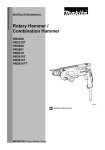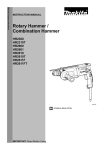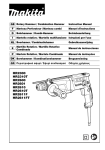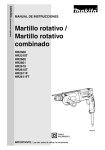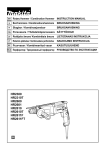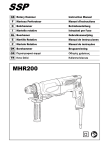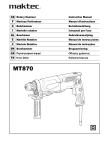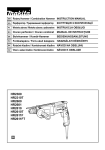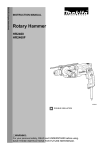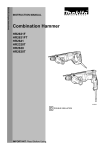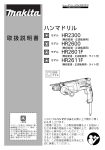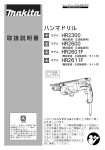Download Makita HR2300 rotary hammer
Transcript
GB Rotary Hammer / Combination Hammer Instruction Manual F Marteau Perforateur / Marteau combi Manuel d’instructions D Bohrhammer / Kombi-Hammer Betriebsanleitung I Martello rotativo / Martello multifunzione Istruzioni per l’uso NL Boorhamer / Combinatiehamer Gebruiksaanwijzing E Martillo Rotativo / Martillo Rotativo Combinado Manual de instrucciones P Martelo Rotativo / Martele Combinado Manual de instruções DK Borehammer / Kombinationshammer Brugsanvisning GR Περιστροφικ σφυρί / Σφυρί συνδυασμού Οδηγίες χρήσεως HR2300 HR2310T HR2600 HR2601 HR2610 HR2610T HR2611F HR2611FT 1 2 3 1 2 5 B A 4 6 3 4 10 8 9 6 5 7 11 12 6 10 12 7 2 11 8 7 14 15 13 9 10 17 16 18 11 12 18 19 12 13 14 20 2 21 15 16 3 2 22 23 17 18 23 24 22 19 20 25 15 18 19 24 21 22 26 27 28 23 4 24 30 29 30 31 32 28 28 25 26 27 28 33 29 30 5 34 35 31 6 7 32 5 36 8 9 37 7 6 33 34 24 35 6 9 ENGLISH (Original instructions) Explanation of general view 1 2 3 4 5 6 7 8 9 10 11 12 13 Switch trigger Lock button Lamp Reversing switch lever Quick change chuck for SDSplus Change cover line Change cover Spindle Quick change drill chuck Rotation with hammering Rotation only Action mode changing knob Hammering only 14 15 16 17 18 19 20 21 22 Protrusions Grooves Bit shank Bit grease Bit Chuck cover Grip base Depth gauge Toothed side of hex hole marking on the grip base 23 Toothed side of the depth gauge 24 Dust cup 25 △ symbol 26 Attachment at the foot of dust cup 27 Bellows 28 Attachment 29 Carved side 30 Cap 31 Groove 32 Inside periphery 33 Blow-out bulb 34 Chuck adapter 35 Keyless drill chuck 36 Sleeve 37 Ring SPECIFICATIONS Model HR2300 HR2310T HR2600 HR2601 HR2610 HR2610T HR2611F HR2611FT Concrete 23 mm Core bit 68 mm 68 mm 68 mm 70 mm 80 mm 80 mm Steel 13 mm 13 mm 13 mm Wood 32 mm 32 mm 32 mm Capacities Diamond core bit (dry type) No load speed 26 mm (min-1) 0 - 1,200 Blows per minute 0 - 4,600 Overall length 356 mm 380 mm Net weight 2.7 kg 2.9 kg 361 mm 2.8 kg Safety class 2.9 kg 2.8 kg 385 mm 361 mm 385 mm 2.9 kg 2.9 kg 3.0 kg /II • Due to our continuing programme of research and development, the specifications herein are subject to change without notice. • Specifications may differ from country to country. • Weight according to EPTA-Procedure 01/2003 ENE042-1 Intended use The tool is intended for hammer drilling and drilling in brick, concrete and stone. It is also suitable for drilling without impact in wood, metal, ceramic and plastic. GEB007-7 ROTARY HAMMER SAFETY WARNINGS 1. 2. 3. ENF002-1 Power supply The tool should be connected only to a power supply of the same voltage as indicated on the nameplate, and can only be operated on single-phase AC supply. They are double-insulated in accordance with European Standard and can, therefore, also be used from sockets without earth wire. 4. GEA010-1 6. General Power Tool Safety Warnings WARNING Read all safety warnings and all instructions. Failure to follow the warnings and instructions may result in electric shock, fire and/or serious injury. 5. Wear ear protectors. Exposure to noise can cause hearing loss. Use auxiliary handle(s), if supplied with the tool. Loss of control can cause personal injury. Hold power tool by insulated gripping surfaces, when performing an operation where the cutting accessory may contact hidden wiring or its own cord. Cutting accessory contacting a “live” wire may make exposed metal parts of the power tool “live” and could give the operator an electric shock. Wear a hard hat (safety helmet), safety glasses and/or face shield. Ordinary eye or sun glasses are NOT safety glasses. It is also highly recommended that you wear a dust mask and thickly padded gloves. Be sure the bit is secured in place before operation. Under normal operation, the tool is designed to produce vibration. The screws can come loose easily, causing a breakdown or accident. Check tightness of screws carefully before operation. Save all warnings and instructions for future reference. 7 7. 8. 9. 10. 11. 12. 13. 14. In cold weather or when the tool has not been used for a long time, let the tool warm up for a while by operating it under no load. This will loosen up the lubrication. Without proper warm up, hammering operation is difficult. Always be sure you have a firm footing. Be sure no one is below when using the tool in high locations. Hold the tool firmly with both hands. Keep hands away from moving parts. Do not leave the tool running. Operate the tool only when hand-held. Do not point the tool at any one in the area when operating. The bit could fly out and injure someone seriously. Do not touch the bit or parts close to the bit immediately after operation; they may be extremely hot and could burn your skin. Some material contains chemicals which may be toxic. Take caution to prevent dust inhalation and skin contact. Follow material supplier safety data. SAVE THESE INSTRUCTIONS. WARNING: DO NOT let comfort or familiarity with product (gained from repeated use) replace strict adherence to safety rules for the subject product. MISUSE or failure to follow the safety rules stated in this instruction manual may cause serious personal injury. FUNCTIONAL DESCRIPTION CAUTION: • Always be sure that the tool is switched off and unplugged before adjusting or checking function on the tool. Switch action (Fig. 1) CAUTION: • Before plugging in the tool, always check to see that the switch trigger actuates properly and returns to the “OFF” position when released. To start the tool, simply pull the switch trigger. Tool speed is increased by increasing pressure on the switch trigger. Release the switch trigger to stop. For continuous operation, pull the switch trigger and then push in the lock button and then release the switch trigger. To stop the tool from the locked position, pull the switch trigger fully, then release it. Lighting up the lamps (Fig. 2) For models HR2611F, HR2611FT CAUTION: • Do not look in the light or see the source of light directly. To turn on the lamp, pull the trigger. Release the trigger to turn it off. NOTE: • Use a dry cloth to wipe the dirt off the lens of lamp. Be careful not to scratch the lens of lamp, or it may lower the illumination. • Do not use thinner or gasoline to clean the lamp. Such solvents may damage it. 8 Reversing switch action (Fig. 3) CAUTION: • Always check the direction of rotation before operation. • Use the reversing switch only after the tool comes to a complete stop. Changing the direction of rotation before the tool stops may damage the tool. • If the switch trigger can not be depressed, check to see that the reversing switch is fully set to position (A side) or (B side). This tool has a reversing switch to change the direction of rotation. Move the reversing switch lever to the position (A side) for clockwise rotation or to the position (B side) for counterclockwise rotation. Changing the quick change chuck for SDS-plus For Models HR2310T, HR2610T, HR2611FT The quick change chuck for SDS-plus can be easily exchanged for the quick change drill chuck. Removing the quick change chuck for SDS-plus (Fig. 4) CAUTION: • Before removing the quick change chuck for SDS-plus, always remove the bit. Grasp the change cover of the quick change chuck for SDS-plus and turn in the direction of the arrow until the change cover line moves from the symbol to the symbol. Pull forcefully in the direction of the arrow. Attaching the quick change drill chuck (Fig. 5) Check the line of the quick change drill chuck shows the symbol. Grasp the change cover of the quick change drill chuck and set the line to the symbol. Place the quick change drill chuck on the spindle of the tool. Grasp the change cover of the quick change drill chuck and turn the change cover line to the symbol until a click can clearly be heard. Selection action mode (Fig. 6) For Models HR2300, HR2600, HR2601 This tool employs an action mode changing knob. Select one of the two modes suitable for your work needs by using this knob. For rotation only, turn the knob so that the arrow on the knob points toward the m symbol on the tool body. For rotation with hammering, turn the knob so that the arrow on the knob points toward the symbol on the tool body. CAUTION: • Always set the knob fully to your desired mode symbol. If you operate the tool with the knob positioned halfway between the mode symbols, the tool may be damaged. • Use the knob after the tool comes to a complete stop. For Models HR2310T, HR2610, HR2610T, HR2611F, HR2611FT Rotation with hammering (Fig. 7) For drilling in concrete, masonry, etc., rotate the action mode changing knob to the symbol. Use a tungstencarbide tipped bit. Rotation only (Fig. 8) For drilling in wood, metal or plastic materials, rotate the action mode changing knob to the m symbol. Use a twist drill bit or wood bit. Hammering only (Fig. 9) For chipping, scaling or demolition operations, rotate the action mode changing knob to the g symbol. Use a bull point, cold chisel, scaling chisel, etc. CAUTION: • Do not rotate the action mode changing knob when the tool is running under load. The tool will be damaged. • To avoid rapid wear on the mode change mechanism, be sure that the action mode changing knob is always positively located in one of the three action mode positions. • When changing from the g symbol mode to the m symbol mode, the action mode changing knob may no longer move in the symbol position. At this time, turn the tool on or turn the chuck by hand in the symbol position and then rotate the action mode changing knob. Forcing the action mode changing knob may cause tool damage. Torque limiter The torque limiter will actuate when a certain torque level is reached. The motor will disengage from the output shaft. When this happens, the bit will stop turning. CAUTION: • As soon as the torque limiter actuates, switch off the tool immediately. This will help prevent premature wear of the tool. • Bits such as hole saw, which tend to pinch or catch easily in the hole, are not appropriate for this tool. This is because they will cause the torque limiter to actuate too frequently. Bit angle (when chipping, scaling or demolishing) For Models HR2310T, HR2610, HR2610T, HR2611F, HR2611FT The bit can be secured at the desired angle. To change the bit angle, rotate the action mode changing knob to the O symbol. Turn the bit to the desired angle. (Fig. 14) Rotate the action mode changing knob to the g symbol. (Fig. 15) Then make sure that the bit is securely held in place by turning it slightly. Depth gauge The depth gauge is convenient for drilling holes of uniform depth. (Fig. 16) Press the lock button on the grip base in the direction of arrow shown in the figure and with the lock button being pressed insert the depth gauge into the hex. hole in the grip base. (Fig. 17) At this time, the depth gauge needs to be inserted so that its toothed side is directed to the toothed side of hex hole marking on the grip base as shown in Fig. 18. Adjust the depth gauge to the desired depth by moving it back and forth while pressing the lock button. After the adjustment, release the lock button to lock the depth gauge. (Fig. 19) NOTE: • Inserting the depth gauge with its toothed side not directed to the toothed side of hex hole marking on the grip base as shown in the figure does not allow the depth gauge to be locked. Dust cup (Fig. 20) ASSEMBLY CAUTION: • Always be sure that the tool is switched off and unplugged before carrying out any work on the tool. Use the dust cup to prevent dust from falling over the tool and on yourself when performing overhead drilling operations. Attach the dust cup to the bit as shown in Fig. 20. The size of bits which the dust cup can be attached to is as follows. Side grip (auxiliary handle) (Fig. 10) CAUTION: • Always use the side grip to ensure operating safety. Install the side grip so that the protrusions on the grip fit in between the grooves on the tool barrel. Then tighten the grip by turning clockwise at the desired position. It may be swung 360° so as to be secured at any position. Bit grease Coat the bit shank head beforehand with a small amount of bit grease (about 0.5 – 1 g). This chuck lubrication assures smooth action and longer service life. Installing or removing the bit Clean the bit shank and apply bit grease before installing the bit. (Fig. 11) Insert the bit into the tool. Turn the bit and push it in until it engages. (Fig. 12) After installing, always make sure that the bit is securely held in place by trying to pull it out. To remove the bit, pull the chuck cover down all the way and pull the bit out. (Fig. 13) Bit diameter Dust cup 5 6 mm – 14.5 mm Dust cup 9 12 mm – 16 mm There is another type of dust cup (accessory) which helps you prevent dust from falling over the tool and on yourself when performing overhead drilling operations. Installing or removing the dust cup Before installing the dust cup, remove the bit from the tool if installed on the tool. Install the dust cup (accessory) on the tool so that the △ symbol on the dust cup is aligned with the grooves in the tool. (Fig. 21) To remove the dust cup, pull the chuck cover in the direction as shown in Fig. 22 and with the chuck cover pulled take the bit out of the tool. And then grab the attachment at the foot of dust cup and take it out. (Fig. 23) NOTE: • When installing or removing the dust cup, the cap may come off the dust cup. At that time, proceed as follows. Remove the bellows from the attachment and fit the cap with its carved side facing upward so that the groove in the cap fits in the inside periphery of the attachment. Finally, mount the bellows that has been removed. (Fig. 24, 25 & 26) 9 NOTE: • If you connect a vacuum cleaner to your hammer, cleaner operations can be performed. Dust cap needs to be removed from the dust cup before the connection. (Fig. 27) OPERATION Always use the side grip (auxiliary handle) and firmly hold the tool by both side grip and switch handle during operations. Hammer drilling operation (Fig. 28) Set the action mode changing knob to the symbol. Position the bit at the desired location for the hole, then pull the switch trigger. Do not force the tool. Light pressure gives best results. Keep the tool in position and prevent it from slipping away from the hole. Do not apply more pressure when the hole becomes clogged with chips or particles. Instead, run the tool at an idle, then remove the bit partially from the hole. By repeating this several times, the hole will be cleaned out and normal drilling may be resumed. Set the action mode changing knob to the symbol. CAUTION: • There is tremendous and sudden twisting force exerted on the tool/bit at the time of hole break-through, when the hole becomes clogged with chips and particles, or when striking reinforcing rods embedded in the concrete. Always use the side grip (auxiliary handle) and firmly hold the tool by both side grip and switch handle during operations. Failure to do so may result in the loss of control of the tool and potentially severe injury. NOTE: • Eccentricity in the bit rotation may occur while operating the tool with no load. The tool automatically centers itself during operation. This does not affect the drilling precision. Blow-out bulb (optional accessory) (Fig. 29) After drilling the hole, use the blow-out bulb to clean the dust out of the hole. Chipping/Scaling/Demolition For Models HR2310T, HR2610, HR2610T, HR2611F, HR2611FT Set the action mode changing knob to the g symbol. Hold the tool firmly with both hands. Turn the tool on and apply slight pressure on the tool so that the tool will not bounce around, uncontrolled. Pressing very hard on the tool will not increase the efficiency. (Fig. 30) Drilling in wood or metal For Models HR2300, HR2600, HR2601, HR2610, HR2611F Use the optional drill chuck assembly. When installing it, refer to “Installing or removing the bit” described on the previous page. (Fig. 31) 10 For Models HR2310T, HR2610T, HR2611FT Use the quick change drill chuck as standard equipment. When installing it, refer to “changing the quick change chuck for SDS-plus” described on the previous page. (Fig. 32 & 33) Hold the ring and turn the sleeve counterclockwise to open the chuck jaws. Place the bit in the chuck as far as it will go. Hold the ring firmly and turn the sleeve clockwise to tighten the chuck. To remove the bit, hold the ring and turn the sleeve counterclockwise. (Fig. 34) Set the action mode changing knob to the m symbol. You can drill up to 13 mm diameter in metal and up to 32 mm diameter in wood. CAUTION: • Never use “rotation with hammering” when the quick change drill chuck is installed on the tool. The quick change drill chuck may be damaged. Also, the drill chuck will come off when reversing the tool. • Pressing excessively on the tool will not speed up the drilling. In fact, this excessive pressure will only serve to damage the tip of your bit, decrease the tool performance and shorten the service life of the tool. • There is a tremendous twisting force exerted on the tool/bit at the time of hole breakthrough. Hold the tool firmly and exert care when the bit begins to break through the workpiece. • A stuck bit can be removed simply by setting the reversing switch to reverse rotation in order to back out. However, the tool may back out abruptly if you do not hold it firmly. • Always secure small workpieces in a vise or similar hold-down device. Diamond core drilling When performing diamond core drilling operations, always set the change lever to the m position to use “rotation only” action. CAUTION: • If performing diamond core drilling operations using “rotation with hammering” action, the diamond core bit may be damaged. Operation when using the dust cup (accessory) (Fig. 35) Operate the tool with the dust cup against the ceiling surface. NOTE: • The dust cup (accessory) is intended only for drilling in the ceramic workpiece such as concrete and mortar. Do not use the tool with the dust cup when drilling in metal or similar. Using the dust cup for drilling in the metal may damage the dust cup due to the heat produced by small metal dust or similar. • Empty the dust cup before removing a drill bit. • When using the dust cup, make sure that the dust cap is mounted on it securely. MAINTENANCE ENG900-1 CAUTION: • Always be sure that the tool is switched off and unplugged before attempting to perform inspection or maintenance. • Never use gasoline, benzine, thinner, alcohol or the like. Discoloration, deformation or cracks may result. To maintain product SAFETY and RELIABILITY, repairs, carbon brush inspection and replacement, any other maintenance or adjustment should be performed by Makita Authorized Service Centers, always using Makita replacement parts. OPTIONAL ACCESSORIES CAUTION: • These accessories or attachments are recommended for use with your Makita tool specified in this manual. The use of any other accessories or attachments might present a risk of injury to persons. Only use accessory or attachment for its stated purpose. If you need any assistance for more details regarding these accessories, ask your local Makita Service Center. • SDS-Plus Carbide-tipped bits • Core bit • Bull point • Diamond core bit • Cold chisel • Scaling chisel • Grooving chisel • Drill chuck assembly • Drill chuck S13 • Chuck adapter • Chuck key S13 • Bit grease • Side grip • Depth gauge • Blow-out bulb • Dust cup • Dust extractor attachment • Safety goggles • Plastic carrying case • Keyless drill chuck NOTE • Some items in the list may be included in the tool package as standard accessories. They may differ from country to country. ENG905-1 Noise The typical A-weighted noise level determined according to EN60745: Model HR2300, HR2601, HR2611F, HR2611FT Sound pressure level (LpA): 90 dB (A) Sound power level (LWA): 101 dB (A) Uncertainty (K): 3 dB (A) Model HR2310T, HR2600, HR2610, HR2610T Sound pressure level (LpA): 91 dB (A) Sound power level (LWA): 102 dB (A) Uncertainty (K): 3 dB (A) Wear ear protection Vibration The vibration total value (tri-axial vector sum) determined according to EN60745: Model HR2300, HR2600 Work mode: hammer drilling into concrete Vibration emission (ah, HD): 15.5 m/s2 Uncertainty (K): 1.5 m/s2 Work mode: drilling into metal Vibration emission (ah, D): 2.5 m/s2 Uncertainty (K): 1.5 m/s2 Model HR2310T Work mode: hammer drilling into concrete Vibration emission (ah, HD): 15.5 m/s2 Uncertainty (K): 1.5 m/s2 Work mode: chiseling function with side grip Vibration emission (ah, CHeq): 10.5 m/s2 Uncertainty (K): 1.5 m/s2 Work mode: drilling into metal Vibration emission (ah, D): 2.5 m/s2 or less Uncertainty (K): 1.5 m/s2 Model HR2601 Work mode: hammer drilling into concrete Vibration emission (ah, HD): 12.0 m/s2 Uncertainty (K): 1.5 m/s2 Work mode: drilling into metal Vibration emission (ah, D): 2.5 m/s2 or less Uncertainty (K): 1.5 m/s2 Model HR2610 Work mode: hammer drilling into concrete Vibration emission (ah, HD): 15.5 m/s2 Uncertainty (K): 1.5 m/s2 Work mode: chiseling function with side grip Vibration emission (ah, CHeq): 9.5 m/s2 Uncertainty (K): 1.5 m/s2 Work mode: drilling into metal Vibration emission (ah, D): 2.5 m/s2 Uncertainty (K): 1.5 m/s2 Model HR2610T Work mode: hammer drilling into concrete Vibration emission (ah, HD): 15.0 m/s2 Uncertainty (K): 1.5 m/s2 Work mode: chiseling function with side grip Vibration emission (ah, CHeq): 9.5 m/s2 Uncertainty (K): 1.5 m/s2 Work mode: drilling into metal Vibration emission (ah, D): 2.5 m/s2 or less Uncertainty (K): 1.5 m/s2 Model HR2611F Work mode: hammer drilling into concrete Vibration emission (ah, HD): 12.0 m/s2 Uncertainty (K): 1.5 m/s2 Work mode: chiseling function with side grip Vibration emission (ah, CHeq): 9.0 m/s2 Uncertainty (K): 1.5 m/s2 Work mode: drilling into metal Vibration emission (ah, D): 2.5 m/s2 or less Uncertainty (K): 1.5 m/s2 11 Model HR2611FT Work mode: hammer drilling into concrete Vibration emission (ah, HD): 11.5 m/s2 Uncertainty (K): 1.5 m/s2 ENH101-15 For European countries only EC Declaration of Conformity Work mode: chiseling function with side grip Vibration emission (ah, CHeq): 8.5 m/s2 Uncertainty (K): 1.5 m/s2 Work mode: drilling into metal Vibration emission (ah, D): 2.5 m/s2 or less Uncertainty (K): 1.5 m/s2 ENG901-1 • The declared vibration emission value has been measured in accordance with the standard test method and may be used for comparing one tool with another. • The declared vibration emission value may also be used in a preliminary assessment of exposure. WARNING: • The vibration emission during actual use of the power tool can differ from the declared emission value depending on the ways in which the tool is used. • Be sure to identify safety measures to protect the operator that are based on an estimation of exposure in the actual conditions of use (taking account of all parts of the operating cycle such as the times when the tool is switched off and when it is running idle in addition to the trigger time). We Makita Corporation as the responsible manufacturer declare that the following Makita machine(s): Designation of Machine: Combination Hammer Model No./ Type: HR2610, HR2610T, HR2611F, HR2611FT are of series production and Conforms to the following European Directives: 2006/42/EC And are manufactured in accordance with the following standards or standardised documents: EN60745 The technical documentation is kept by our authorized representative in Europe who is: Makita International Europe Ltd. Michigan Drive, Tongwell, Milton Keynes, Bucks MK15 8JD, England 13.7.2009 Tomoyasu Kato Director ENH101-15 For European countries only EC Declaration of Conformity We Makita Corporation as the responsible manufacturer declare that the following Makita machine(s): Designation of Machine: Rotary Hammer Model No./ Type: HR2300, HR2310T, HR2600, HR2601 are of series production and Conforms to the following European Directives: 2006/42/EC And are manufactured in accordance with the following standards or standardised documents: EN60745 The technical documentation is kept by our authorized representative in Europe who is: Makita International Europe Ltd. Michigan Drive, Tongwell, Milton Keynes, Bucks MK15 8JD, England 13.7.2009 Tomoyasu Kato Director Makita Corporation 3-11-8, Sumiyoshi-cho, Anjo, Aichi, 446-8502, JAPAN 12 Makita Corporation 3-11-8, Sumiyoshi-cho, Anjo, Aichi, 446-8502, JAPAN NEDERLANDS (Originele instructies) Verklaring van algemene gegevens 1 2 3 4 5 6 7 8 9 10 11 12 13 14 Aan/uit-schakelaar Vergrendelknop Lampje Omkeerschakelaar Snelwisselkop voor SDS-plus Streep op wisselmof Wisselmof As Snelwisselboorkop Ronddraaien met hameren Alleen ronddraaien Werkingsfunctie-keuzeknop Alleen hameren Uitsteeksels 15 16 17 18 19 20 21 22 Groeven Boorschacht Boorvet Boor Boorkopmof Basis van de zijhandgreep Diepteaanslag Getande kant van de zeskantgatmarkering op de basis van de zijhandgreep 23 Getande zijde van de diepteaanslag 24 Stofvanger 25 Symbool △ 26 27 28 29 30 31 32 33 34 35 36 37 Voetstuk van de stofvanger Balg Voetstuk Bolle kant Dop Groef Binnenomtrek Blaasbalgje Boorkopadapter Sleutelloze boorkop Mof Ring TECHNISCHE GEGEVENS Model Maximale dikten HR2300 HR2310T HR2600 HR2610 HR2610T HR2611F HR2611FT 23 mm Kroonboor 68 mm 68 mm 68 mm Diamantkroonboor (droog type) 70 mm 80 mm 80 mm Staal 13 mm 13 mm 13 mm Hout 32 mm 32 mm 26 mm 32 mm Nullasttoerental (min-1) 0 - 1 200 Aantal slagen/minuut 0 - 4 600 Totale lengte 356 mm 380 mm Nettogewicht 2,7 kg 2,9 kg 361 mm 2,8 kg Veiligheidsklasse 2,9 kg 2,8 kg 385 mm 361 mm 385 mm 2,9 kg 2,9 kg 3,0 kg /II • In verband met ononderbroken research en ontwikkeling behouden wij ons het recht voor bovenstaande technische gegevens te wijzigen zonder voorafgaande kennisgeving. • De technische gegevens kunnen van land tot land verschillen. • Gewicht volgens de EPTA-procedure 01/2003 ENE042-1 Gebruiksdoeleinden Het gereedschap is bedoeld voor hamerboren en boren in baksteen, beton en steen. Het is ook geschikt voor boren zonder slagwerking in hout, metaal, keramisch materiaal en kunststof. ENF002-1 Voeding Het gereedschap mag uitsluitend worden aangesloten op een voeding met dezelfde spanning als aangegeven op het typeplaatje en werkt alleen op enkele-fase wisselstroom. Het gereedschap is dubbel geïsoleerd volgens de Europese norm en mag derhalve ook op een nietgeaard stopcontact worden aangesloten. 34 HR2601 Beton GEA010-1 Algemene veiligheidswaarschuwingen voor elektrisch gereedschap WAARSCHUWING Lees alle veiligheidswaarschuwingen en alle instructies. Het niet volgen van de waarschuwingen en instructies kan leiden tot elektrische schokken, brand en/of ernstig letsel. Bewaar alle waarschuwingen en instructies om in de toekomst te kunnen raadplegen. GEB007-7 VEILIGHEIDSWAARSCHUWINGEN SPECIFIEK VOOR EEN BOORHAMER 1. 2. Draag gehoorbescherming. Blootstelling aan harde geluiden kan leiden tot gehoorbeschadiging. Gebruik de hulphandgrepen, als deze bij het gereedschap werden geleverd. Als u de controle over het gereedschap verliest, kan dit leiden tot ernstig persoonlijk letsel. 3. 4. 5. 6. 7. 8. 9. 10. 11. 12. 13. 14. Houd elektrisch gereedschap vast aan het geïsoleerde oppervlak van de handgrepen wanneer u werkt op plaatsen waar het booraccessoire met verborgen bedrading of zijn eigen snoer in aanraking kan komen. Wanneer het booraccessoire in aanraking komen met onder spanning staande draden, zullen de niet-geïsoleerde metalen delen van het gereedschap onder spanning komt te staan zodat de gebruiker een elektrische schok kan krijgen. Draag een veiligheidshelm, veiligheidsbril en/of spatscherm. Een gewone bril of een zonnebril is GEEN veiligheidsbril. Het wordt tevens sterk aanbevolen een stofmasker en dik gevoerde handschoenen te dragen. Controleer of de boor stevig op zijn plaats zit voordat u het gereedschap gebruikt. Bij normale bediening behoort het gereedschap te trillen. De schroeven kunnen gemakkelijk losraken, waardoor een defect of ongeval kan ontstaan. Controleer of de schroeven goed zijn aangedraaid, alvorens het gereedschap te gebruiken. In koude weersomstandigheden of wanneer het gereedschap gedurende een lange tijd niet is gebruikt, laat u het gereedschap eerst opwarmen door het onbelast te laten werken. Hierdoor zal de smering worden verbeterd. Zonder degelijk opwarmen, zal de hamerwerking moeilijk zijn. Zorg er altijd voor dat u stevig staat. Zorg ervoor dat er niemand zich onder u bevindt wanneer u het gereedschap op een hoge plaats gebruikt. Houd het gereedschap met beide handen stevig vast. Houd uw handen uit de buurt van bewegende delen. Laat het gereedschap niet ingeschakeld liggen. Bedien het gereedschap alleen wanneer u het vasthoudt. Richt het gereedschap niet op iemand in de buurt terwijl het is ingeschakeld. De boor zou eruit kunnen vliegen en iemand ernstig verwonden. Raak de boor en onderdelen in de buurt van de boor niet onmiddellijk na gebruik aan. Zij kunnen bijzonder heet zijn en brandwonden op uw huid veroorzaken. Sommige materialen bevatten chemische stoffen die giftig kunnen zijn. Neem voorzorgsmaatregelen tegen het inademen van stof en contact met de huid. Volg de veiligheidsinstructies van de leverancier van het materiaal op. BEWAAR DEZE INSTRUCTIES WAARSCHUWING: Laat u NIET misleiden door een vals gevoel van comfort en bekendheid met het gereedschap (na veelvuldig gebruik) en neem alle veiligheidsvoorschriften van het betreffende product altijd strikt in acht. VERKEERD GEBRUIK of het niet volgen van de veiligheidsinstructies in deze gebruiksaanwijzing kan leiden tot ernstig persoonlijk letsel. BESCHRIJVING VAN DE FUNCTIES LET OP: • Controleer altijd of het gereedschap is uitgeschakeld en de stekker uit het stopcontact is getrokken alvorens de functies van het gereedschap te controleren of af te stellen. Aan- en uit-knoppen (Fig. 1) LET OP: • Controleer altijd, voordat u de stekker in het stopcontact steekt, of de aan/uit-schakelaar op de juiste manier schakelt en weer terugkeert naar de uit-stand nadat deze is losgelaten. Om het gereedschap in te schakelen, knijpt u gewoon de aan/uit-schakelaar in. De draaisnelheid van het gereedschap neemt toe naarmate u meer druk uitoefent op de aan/uit-schakelaar. Laat de aan/uit-schakelaar los om het gereedschap te stoppen. Om het gereedschap continu te laten werken, knijpt u eerst de aan/uit-schakelaar in, drukt u daarna de vergrendelknop in, en laat u tenslotte de aan/uit-schakelaar los. Om vanuit de vergrendelde werking het gereedschap te stoppen, knijpt u de aan/uitschakelaar helemaal in en laat u deze vervolgens weer los. De lamp inschakelen (Fig. 2) Voor modellen HR2611F en HR2611FT LET OP: • Kijk niet rechtstreeks in het licht of naar de bron van de lamp. Trek aan de aan/uit-schakelaar om de lamp in te schakelen. Laat de aan/uit-schakelaar los om de lamp uit te schakelen. OPMERKING: • Gebruik een droge doek om het vuil van de lens van de lamp te vegen. Wees voorzichtig de lens van de lamp niet te bekrassen om de lichtopbrengst niet te verlagen. • Maak de lens van de lamp niet schoon met verdunner of benzine. Dergelijke oplosmiddelen kunnen de lens van de lamp beschadigen. Werking van de omkeerschakelaar (Fig. 3) LET OP: • Controleer altijd de draairichting alvorens het gereedschap te gebruiken. • Gebruik de omkeerschakelaar alleen nadat het gereedschap volledig tot stilstand is gekomen. Als u de draairichting verandert voordat het gereedschap volledig stilstaat, kan het gereedschap worden beschadigd. • Als de aan/uit-schakelaar niet kan worden ingeknepen, controleert u dat de omkeerschakelaar helemaal naar de stand (kant A) of naar de stand (kant B) is gezet. Dit gereedschap is uitgerust met een omkeerschakelaar waarmee u de draairichting kunt omkeren. Duw de omkeerschakelaar naar stand (kant A) voor de draairichting rechtsom, of naar stand (kant B) voor de draairichting linksom. 35 De snelwisselkop voor SDS-plus vervangen Voor modellen HR2310T, HR2610T en HR2611FT De snelwisselkop voor SDS-plus kan eenvoudig worden vervangen door de snelwisselboorkop. De snelwisselkop voor SDS-plus verwijderen (Fig. 4) LET OP: • Haal altijd de boor eruit voordat u de snelwisselkop voor SDS-plus verwijdert. • Als u de knop van het symbool g naar het symbool m draait, is het mogelijk dat de werkingsfunctie-keuzewilt draaien. In knop niet verder dan het symbool dat geval schakelt u het gereedschap in of draai de boorkop met de hand, terwijl de werkingsfunctie-keuzestaat, en draait u vervolgens knop op het symbool de werkingsfunctie-keuzeknop verder. Als u de werkingsfunctie-keuzeknop forceert, kan het gereedschap worden beschadigd. Pak de wisselmof van de snelwisselkop voor SDS-plus vast en draai deze in de richting van de pijl totdat de streep op de wisselmof van het symbool naar het symbool is verplaatst. Trek krachtig in de richting van de pijl. Koppelbegrenzer De snelwisselboorkop aanbrengen (Fig. 5) Controleer of de streep op de snelwisselboorkop bij het symbool staat. Pak de wisselmof van de snelwisselboorkop vast en zet de streep bij het symbool . Zet de snelwisselboorkop op de as van het gereedschap. Pak de wisselmof van de snelwisselboorkop en draai de streep op de wisselmof naar het symbool totdat een duidelijke klik wordt gehoord. LET OP: • Schakel het gereedschap onmiddellijk uit wanneer de koppelbegrenzer in werking treedt. Hiermee helpt u vroegtijdige slijtage van het gereedschap voorkomen. • Opzetstukken, zoals gatenzagen, die gemakkelijk bekneld raken in het boorgat, mogen niet worden gebruikt met dit gereedschap. Dit is omdat zij de koppelbegrenzer te vaak in werking doen treden. De koppelbegrenzer treedt in werking wanneer de motor een bepaald koppel bereikt. De motor wordt dan ontkoppeld van de uitgaande as. Wanneer dit gebeurt, zal de boor ophouden met draaien. De werkingsfunctie kiezen (Fig. 6) Voor modellen HR2300, HR2600 en HR2601 Dit gereedschap is uitgerust met een werkingsfunctiekeuzeknop. Kies met de werkingsfunctie-keuzeknop één van de twee beschikbare werkingsfuncties die het meest geschikt is voor uw klus. Voor alleen ronddraaien, draait u de werkingsfunctie-keuzeknop zodat de pijlpunt op de knop naar het symbool m op het gereedschap wijst. Voor ronddraaien met hameren draait u de werkingsfunctie-keuzeknop zodat de pijlpunt op de knop naar het symbool op het gereedschap wijst. LET OP: • Stel de werkingsfunctie-keuzeknop altijd volledig in op het symbool van de juiste stand van uw keuze. Als u het gereedschap bedient met de werkingsfunctie-keuzeknop ingesteld tussen de twee werkingsfunctiesymbolen in, kan het gereedschap beschadigd raken. • Draai de werkingsfunctie-keuzeknop alleen nadat het gereedschap volledig tot stilstand is gekomen. Voor modellen HR2310T, HR2610, HR2610T, HR2611F en HR2611FT Ronddraaien met hameren (Fig. 7) Voor het boren in beton, metselwerk, enz., draait u de werkingsfunctie-keuzeknop naar het symbool . Gebruik een boor met een wolfraamcarbide punt. Alleen ronddraaien (Fig. 8) Voor het boren in hout, metaal of kunststofmaterialen, draait u de werkingsfunctie-keuzeknop naar het symbool m. Gebruik een spiraalboor of houtboor. Alleen hameren (Fig. 9) Voor het beitelen, bikken of sloopwerkzaamheden, draait u de werkingsfunctie-keuzeknop naar het symbool g. Gebruik een rond boor, koudbeitel, bikbeitel, enz. LET OP: • Draai de werkingsfunctie-keuzeknop niet terwijl het gereedschap onder belasting draait. Het gereedschap zal hierdoor worden beschadigd. • Om snelle slijtage van het omschakelmechanisme te voorkomen, zorgt u ervoor dat de werkingsfunctie-keuzeknop altijd precies in een van de drie standen staat. 36 INEENZETTEN LET OP: • Controleer altijd of het gereedschap is uitgeschakeld en de stekker uit het stopcontact is getrokken alvorens enige werk aan het gereedschap uit te voeren. Zijhandgreep (hulphandgreep) (Fig. 10) LET OP: • Gebruik altijd de zijhandgreep om veilig te kunnen werken. Plaats de zijhandgreep zodanig over de kop van het gereedschap dat de uitsteeksels van de zijhandgreep in de groeven van het gereedschap passen. Draai daarna de zijhandgreep vast door deze in de gewenste stand rechtsom te draaien. De zijhandgreep kan 360° rond het gereedschap gedraaid worden en in iedere gewenste stand worden vastgezet. Boorvet Voordat u de boor aanbrengt, smeert u een beetje boorvet (ong. 0,5 tot 1 gram) op de kop van de boorschacht. Met een ingevette boorkop zal het gereedschap beter werken en langer meegaan. Aanbrengen en verwijderen van de boor Reinig de boorschacht en smeer er boorvet op alvorens de boor te plaatsen. (Fig. 11) Steek de boor in het gereedschap. Draai de boor en duw deze naar binnen tot zij vergrendelt. (Fig. 12) Controleer na het aanbrengen altijd of de boor stevig in het gereedschap is bevestigd door te proberen deze eruit te trekken. Om de boor te verwijderen, trekt u de boorkopmof helemaal omlaag en vervolgens de boor eruit. (Fig. 13) Boorhoek (bij beitelen, bikken of slopen) Voor modellen HR2310T, HR2610, HR2610T, HR2611F en HR2611FT De boor kan onder de gewenste hoek worden vastgezet. Om de boorhoek te veranderen, draait u de werkingsfunctie-keuzeknop naar het symbool O. Draai de boor naar de gewenste hoek. (Fig. 14) Draai de werkingsfunctie-keuzeknop naar het symbool g. (Fig. 15) Controleer daarna of de boor stevig op zijn plaats vastzit door deze iets te verdraaien. Diepteaanslag De diepteaanslag is handig voor het boren van gaten van gelijke diepte. (Fig. 16) Houd de vergrendelknop op de basis van de zijhandgreep ingedrukt in de richting van de pijl aangegeven in de afbeelding, en steek tegelijkertijd de diepteaanslag in het zeskantgat in de zijhandgreep. (Fig. 17) De diepteaanslag moet zodanig in het zeskantgat worden ingestoken dat de getande zijde van de diepteaanslag wijst naar de getande zijde van de zeskantgatmarkering op de zijhandgreep, zoals aangegeven in Fig. 18. Stel de diepteaanslag af op de gewenste diepte door deze heen en weer te bewegen terwijl u de vergrendelknop ingedrukt houdt. Nadat de diepteaanslag is afgesteld, laat u de vergrendelknop los om de diepteaanslag te vergrendelen. (Fig. 19) OPMERKING: • Als de diepteaanslag in het zeskantgat wordt ingestoken terwijl de getande zijde van de diepteaanslag niet wijst naar de getande zijde van de zeskantgatmarkering op de zijhandgreep, zoals aangegeven in afbeelding, kan de diepteaanslag niet worden vergrendeld. Stofvanger (Fig. 20) Gebruik de stofvanger om te voorkomen dat stof op het gereedschap en op uzelf terechtkomt wanneer u boven uw hoofd boort. Bevestig de stofvanger op de boor zoals aangegeven in Fig. 20. De diameter van de boren waaraan de stofvanger kan worden bevestigd is als volgt. Boordiameter Stofvanger 5 6 mm – 14,5 mm Stofvanger 9 12 mm – 16 mm Er is ook een ander type stofvanger (accessoire) verkrijgbaar dat helpt voorkomen dat stof op het gereedschap en op uzelf terechtkomt wanneer u boven uw hoofd boort. De stofvanger aanbrengen en verwijderen Alvorens de stofvanger aan te brengen, verwijdert u de boor zo nodig uit het gereedschap. Breng de stofvanger (accessoire) zodanig op het gereedschap aan dat het symbool △ op de stofvanger is uitgelijnd met de groeven op het gereedschap. (Fig. 21) Om de stofvanger te verwijderen, houdt u de boorkopmof getrokken in de richting aangegeven in Fig. 22 en trekt u tegelijkertijd de boor uit het gereedschap. Pak vervolgens het voetstuk van de stofvanger vast en trek het van het gereedschap af. (Fig. 23) OPMERKING: • Bij het aanbrengen of verwijderen van de stofvanger kan de dop losraken. Als dat gebeurt, gaat u als volgt te werk: Verwijder de balg vanaf het voetstuk en plaats de dop met zijn bolle kant omhoog in het voetstuk, zodanig dat de groef in de dop past in de binnendiameter van het voetstuk. Plaats ten slotte de balg terug op het voetstuk. (Fig. 24, 25 en 26) OPMERKING: • Als u een stofzuiger aansluit op uw boorhamer, kunt u nog schoner werken. De dop moet uit de stofvanger worden verwijderd voordat u de stofzuiger aansluit. (Fig. 27) BEDIENING Gebruik altijd de zijhandgreep (hulphandgreep) en houd het gereedschap tijdens gebruik stevig vast aan zowel de zijhandgreep als de hoofdhandgreep Gebruik als boorhamer (Fig. 28) Draai de werkingsfunctie-keuzeknop naar het symbool . Plaats de punt van de boor op de gewenste plaats waar het boorgat moet komen en knijp vervolgens de aan/uitschakelaar in. Forceer het gereedschap niet. Een lichte druk geeft de beste resultaten. Houd het gereedschap stevig vast en zorg dat het niet uitglijdt. Oefen geen grotere druk uit wanneer het boorgat verstopt raakt met schilfertjes of metaaldeeltjes. Laat in zo’n geval het gereedschap langzaam lopen en verwijder de boor gedeeltelijk uit het boorgat. Wanneer dit verschillende keren wordt herhaald, zal het boorgat schoon worden en kunt u normaal verder boren. Draai de werkingsfunctie-keuzeknop naar het symbool . LET OP: • Op het moment dat het boorgat doorbreekt, het boorgat verstopt raakt met schilfertjes of metaaldeeltjes, of de boorhamer de bewapening in het beton raakt, wordt een enorme en plotselinge kracht uitgeoefend op het gereedschap/de boor. Gebruik altijd de zijhandgreep (hulphandgreep) en houd het gereedschap tijdens gebruik stevig vast aan zowel de zijhandgreep als de hoofdhandgreep Als u dit niet doet, kunt u de controle over het gereedschap verliezen en mogelijk ernstig letsel veroorzaken. OPMERKING: • Terwijl het gereedschap onbelast wordt gebruikt, kan de boor excentrisch draaien. Het gereedschap centreert zichzelf automatisch tijdens het gebruik. Dit heeft geen nadelige invloed op de nauwkeurigheid van het boren. Blaasbalgje (los verkrijgbaar) (Fig. 29) Gebruik na het boren het blaasbalgje om het stof uit het boorgat te blazen. Beitelen/bikken/slopen Voor modellen HR2310T, HR2610, HR2610T, HR2611F en HR2611FT Draai de werkingsfunctie-keuzeknop naar het symbool g. Houd het gereedschap met beide handen stevig vast. Schakel het gereedschap in en oefen er enige kracht op uit zodat het gereedschap niet oncontroleerbaar in het rond springt. Het gereedschap werkt niet efficiënter als u grote druk op het gereedschap uitoefent. (Fig. 30) 37 Boren in hout of metaal Voor modellen HR2300, HR2600, HR2601, HR2610 en HR2611F Gebruik de los verkrijgbare complete boorkop. Om deze aan te brengen, zie “Aanbrengen en verwijderen van de boor” op de vorige pagina. (Fig. 31) Voor modellen HR2310T, HR2610T en HR2611FT Gebruik de snelwisselboorkop als standaarduitrusting. Om deze aan te brengen, zie “De snelwisselkop voor SDS-plus vervangen” op de vorige pagina. (Fig. 32 en 33) Houd de ring op zijn plaats en draai de bus linksom om de klauwen in de boorkop te openen. Steek de boor zo ver mogelijk in de boorkop. Houd de ring stevig op zijn plaats en draai de bus rechtsom om de klauwen in de boorkop te sluiten. Om de boor te verwijderen, houdt u de ring op zijn plaats en draait u de bus linksom. (Fig. 34) Draai de werkingsfunctie-keuzeknop naar het symbool m. U kunt gaten tot een diameter van 13 mm in metaal en tot een diameter van 32 mm in hout boren. LET OP: • Gebruik nooit “Ronddraaien met hameren” wanneer de snelwisselboorkop op het gereedschap is aangebracht. De snelwisselboorkop kan worden beschadigd. Bovendien zal de boorkop loskomen wanneer de draairichting van het gereedschap wordt omgekeerd. • Het boren zal niet sneller verlopen als u hard op het gereedschap drukt. In feite zal dergelijk hard drukken alleen maar leiden tot beschadiging van de boor, verlaging van de prestaties van het gereedschap, en verkorting van de levensduur van het gereedschap. • Op het moment dat het boorgat doorbreekt wordt een enorme draaikracht uitgeoefend op het gereedschap/ de boor. Houd het gereedschap stevig vast en let goed op wanneer de boor door het werkstuk breekt. • Een vastgelopen boor kan eenvoudigweg worden verwijderd door de omkeerschakelaar in de stand voor achteruitdraaien te zetten en de boor achteruit uit het gat te laten draaien. Het gereedschap kan echter plotseling achteruit komen als u het niet stevig vasthoudt. • Zet kleine werkstukken altijd vast in een bankschroef of soortgelijk bevestigingsmiddel. Diamantkroonboren Wanneer u werkzaamheden met diamantkroonboren uitvoert, moet u de werkingsfunctie-keuzeknop altijd naar het symbool m draaien voor “alleen ronddraaien”. LET OP: • Als u werkzaamheden met diamantkroonboren uitvoert in de stand “ronddraaien met hameren” kan de diamantkroonboor beschadigd raken. Gebruik van de stofvanger (accessoire) (Fig. 35) Bedien het gereedschap met de stofvanger tegen het plafond aan gedrukt. OPMERKING: • De stofvanger (accessoire) is uitsluitend bedoeld voor boren in keramische werkstukken, zoals beton en cement. Gebruik het gereedschap niet met de stofvanger wanneer u in metaal of soortgelijk materiaal boort. Bij gebruik van de stofvanger tijdens het boren in metaal kan de stofvanger worden beschadigd als gevolg van de warmte die door kleine metaaldeeltjes en dergelijke wordt gegenereerd. • Maak de stofvanger leeg voordat u de boor verwijdert. 38 • Zorg ervoor dat bij gebruik van de stofvanger de dop stevig op zijn plaats is aangebracht. ONDERHOUD LET OP: • Zorg er altijd voor dat het gereedschap is uitgeschakeld en de stekker uit het stopcontact is getrokken, voordat u een inspectie of onderhoud uitvoert. • Gebruik nooit benzine, wasbenzine, verdunner, alcohol, enz. Dit kan leiden tot verkleuren, vervormen of barsten. Om de VEILIGHEID en BETROUWBAARHEID van het gereedschap te handhaven, dienen alle reparaties, controle en vervanging van de koolborstels, onderhoud en afstellingen te worden uitgevoerd door een erkend Makita-servicecentrum, en altijd met gebruikmaking van originele Makita-vervangingsonderdelen. OPTIONELE ACCESSOIRES LET OP: • Deze accessoires of hulpstukken worden aanbevolen voor gebruik met het Makita-gereedschap dat in deze gebruiksaanwijzing wordt beschreven. Het gebruik van andere accessoires of hulpstukken kan gevaar voor persoonlijk letsel opleveren. Gebruik de accessoires of hulpstukken uitsluitend voor de aangegeven gebruiksdoeleinden. Mocht u meer informatie willen hebben over deze accessoires, dan kunt u contact opnemen met uw plaatselijke Makita-servicecentrum. • • • • • • • • • • • • • • • • • • • • SDS-Plus boren met een wolfraamcarbide punt Kroonboor Puntbeitel Diamantkroonboor Koudbeitel Bikbeitel Sleuvenbeitel Boorkop montage Boorkop S13 Boorkopadapter Boorkopsleutel S13 Boorvet Zijhandgreep Diepteaanslag Blaasbalgje Stofvanger Voetstuk voor stofvanger Veiligheidsbril Plastic draagkoffer Sleutelloze boorkop OPMERKING: • Sommige van de onderdelen in deze lijst kunnen bijgeleverd zijn als standaard-accessoires. Deze accessoires kunnen per land verschillend zijn. ENG905-1 Geluid De typische, A-gewogen geluidsniveaus zijn gemeten volgens EN60745: Model HR2300, HR2601, HR2611F, HR2611FT Geluidsdrukniveau (LpA): 90 dB (A) Geluidsvermogenniveau (LWA): 101 dB (A) Onnauwkeurigheid (K): 3 dB (A) Model HR2310T, HR2600, HR2610, HR2610T Geluidsdrukniveau (LpA): 91 dB (A) Geluidsvermogenniveau (LWA): 102 dB (A) Onnauwkeurigheid (K): 3 dB (A) Draag gehoorbescherming ENG900-1 Trillingen De totale trillingswaarde (triaxiale vectorsom) zoals vastgesteld volgens EN60745: Model HR2300, HR2600 Gebruikstoepassing: klopboren in beton Trillingsemissie (ah, HD): 15,5 m/s2 Onnauwkeurigheid (K): 1,5 m/s2 Gebruikstoepassing: boren in metaal Trillingsemissie (ah, D): 2,5 m/s2 Onnauwkeurigheid (K): 1,5 m/s2 Model HR2310T Gebruikstoepassing: klopboren in beton Trillingsemissie (ah, HD): 15,5 m/s2 Onnauwkeurigheid (K): 1,5 m/s2 Gebruikstoepassing: beitelen met extra zijhandgreep Trillingsemissie (ah, CHeq): 10,5 m/s2 Onnauwkeurigheid (K): 1,5 m/s2 Gebruikstoepassing: boren in metaal Trillingsemissie (ah, D): 2,5 m/s2 of lager Onnauwkeurigheid (K): 1,5 m/s2 Model HR2601 Gebruikstoepassing: klopboren in beton Trillingsemissie (ah, HD): 12,0 m/s2 Onnauwkeurigheid (K): 1,5 m/s2 Gebruikstoepassing: boren in metaal Trillingsemissie (ah, D): 2,5 m/s2 of lager Onnauwkeurigheid (K): 1,5 m/s2 Model HR2610 Gebruikstoepassing: klopboren in beton Trillingsemissie (ah, HD): 15,5 m/s2 Onnauwkeurigheid (K): 1,5 m/s2 Gebruikstoepassing: beitelen met extra zijhandgreep Trillingsemissie (ah, CHeq): 9,5 m/s2 Onnauwkeurigheid (K): 1,5 m/s2 Gebruikstoepassing: boren in metaal Trillingsemissie (ah, D): 2,5 m/s2 Onnauwkeurigheid (K): 1,5 m/s2 Model HR2610T Gebruikstoepassing: klopboren in beton Trillingsemissie (ah, HD): 15,0 m/s2 Onnauwkeurigheid (K): 1,5 m/s2 Gebruikstoepassing: beitelen met extra zijhandgreep Trillingsemissie (ah, CHeq): 9,5 m/s2 Onnauwkeurigheid (K): 1,5 m/s2 Gebruikstoepassing: boren in metaal Trillingsemissie (ah, D): 2,5 m/s2 of lager Onnauwkeurigheid (K): 1,5 m/s2 Model HR2611F Gebruikstoepassing: klopboren in beton Trillingsemissie (ah, HD): 12,0 m/s2 Onnauwkeurigheid (K): 1,5 m/s2 Gebruikstoepassing: beitelen met extra zijhandgreep Trillingsemissie (ah, CHeq): 9,0 m/s2 Onnauwkeurigheid (K): 1,5 m/s2 Gebruikstoepassing: boren in metaal Trillingsemissie (ah, D): 2,5 m/s2 of lager Onnauwkeurigheid (K): 1,5 m/s2 Model HR2611FT Gebruikstoepassing: klopboren in beton Trillingsemissie (ah, HD): 11,5 m/s2 Onnauwkeurigheid (K): 1,5 m/s2 Gebruikstoepassing: beitelen met extra zijhandgreep Trillingsemissie (ah, CHeq): 8,5 m/s2 Onnauwkeurigheid (K): 1,5 m/s2 Gebruikstoepassing: boren in metaal Trillingsemissie (ah, D): 2,5 m/s2 of lager Onnauwkeurigheid (K): 1,5 m/s2 ENG901-1 • De opgegeven trillingsemissiewaarde is gemeten volgens de standaardtestmethode en kan worden gebruikt om dit gereedschap te vergelijken met andere gereedschappen. • De opgegeven trillingsemissiewaarde kan ook worden gebruikt voor een beoordeling vooraf van de blootstelling. WAARSCHUWING: • De trillingsemissie tijdens het gebruik van het elektrisch gereedschap in de praktijk kan verschillen van de opgegeven trillingsemissiewaarde afhankelijk van de manier waarop het gereedschap wordt gebruikt. • Zorg ervoor dat veiligheidsmaatregelen worden getroffen ter bescherming van de operator die zijn gebaseerd op een schatting van de blootstelling onder praktijkomstandigheden (rekening houdend met alle fasen van de bedrijfscyclus, zoals de tijdsduur gedurende welke het gereedschap is uitgeschakeld en stationair draait, naast de ingeschakelde tijdsduur). 39 ENH101-15 Alleen voor Europese landen ENH101-15 Alleen voor Europese landen EU-verklaring van conformiteit EU-verklaring van conformiteit Wij, Makita Corporation, als de verantwoordelijke fabrikant, verklaren dat de volgende Makitamachine(s): Aanduiding van de machine: Boorhamer Modelnr./Type: HR2300, HR2310T, HR2600, HR2601 in serie zijn geproduceerd en Voldoen aan de volgende Europese richtlijnen: 2006/42/EC En zijn gefabriceerd in overeenstemming met de volgende normen of genormaliseerde documenten: EN60745 De technische documentatie wordt bewaard door onze erkende vertegenwoordiger in Europa, te weten: Makita International Europe Ltd. Michigan Drive, Tongwell, Milton Keynes, Bucks MK15 8JD, Engeland Wij, Makita Corporation, als de verantwoordelijke fabrikant, verklaren dat de volgende Makitamachine(s): Aanduiding van de machine: Combinatiehamer Modelnr./Type: HR2610, HR2610T, HR2611F, HR2611FT in serie zijn geproduceerd en Voldoen aan de volgende Europese richtlijnen: 2006/42/EC En zijn gefabriceerd in overeenstemming met de volgende normen of genormaliseerde documenten: EN60745 De technische documentatie wordt bewaard door onze erkende vertegenwoordiger in Europa, te weten: Makita International Europe Ltd. Michigan Drive, Tongwell, Milton Keynes, Bucks MK15 8JD, Engeland 13.7.2009 13.7.2009 Tomoyasu Kato Directeur Makita Corporation 3-11-8, Sumiyoshi-cho, Anjo, Aichi, 446-8502, JAPAN 40 Tomoyasu Kato Directeur Makita Corporation 3-11-8, Sumiyoshi-cho, Anjo, Aichi, 446-8502, JAPAN
This document in other languages
- Nederlands: Makita HR2610



















